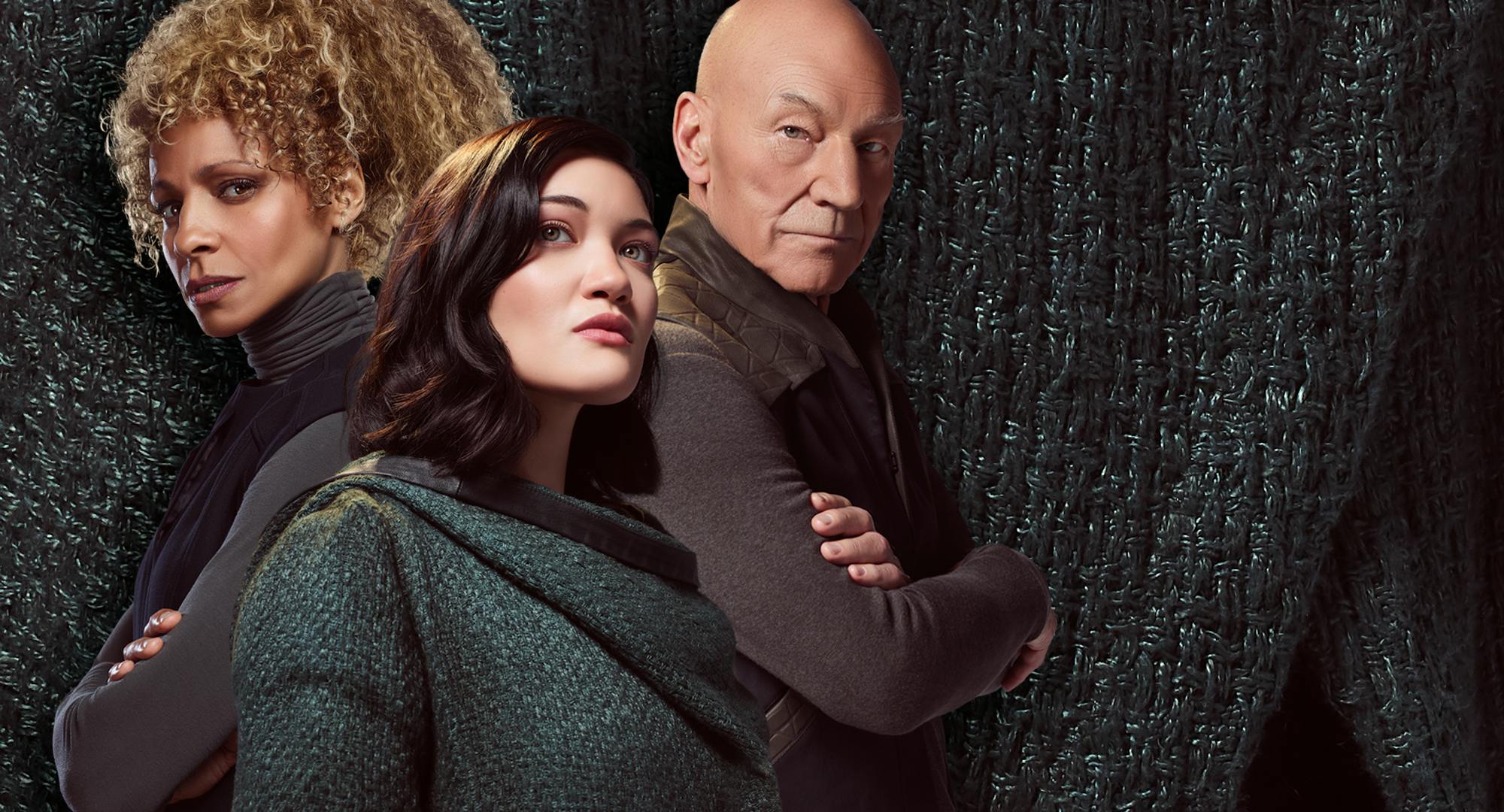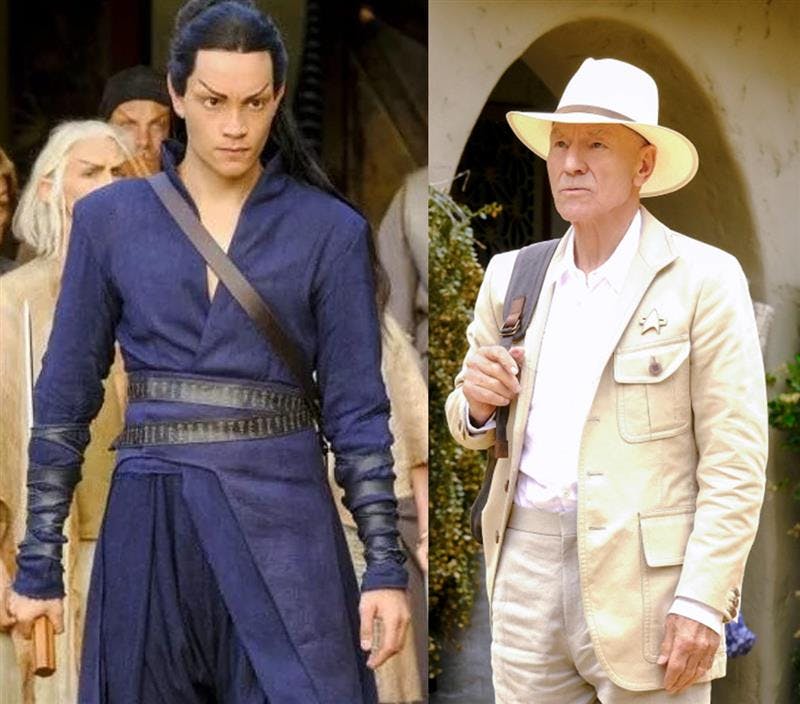Published Mar 2, 2022
The Natural Minimalism of Star Trek: Picard
Fashion blogger Tom Fitzgerald breaks down the universe's new look.

StarTrek.com
This article was originally published on April 1, 2020.
Star Trek: Picard has concluded its first season and with it, established the landscape of a post-Romulus galaxy, offering fans the most far-flung look yet at the shared universe of Star Trek, from politics to science to aesthetics. While it may not be the first thing most fans notice, I couldn’t help but be struck by what everyone was wearing. In less than 20 years’ time, the entire look of the late 24th Century changed drastically and I couldn’t help wondering just who was supplying everyone with all of those gorgeous sweaters.

StarTrek.com
From the bouffants and Beatle boots of The Original Series to the metallics and shoulder pads of Next Generation, to the military uniforms of Enterprise and even all the way to the lens flares and Apple-inspired aesthetic of the J.J. Abrams films, the look of Star Trek has always reflected the aesthetics of the time in which it was originally produced. As both a long-time fan and someone who’s written a good deal about the semiotics of costume design, I’ve always enjoyed the idea that, for instance, in the era of The Original Series, there was a minor vogue or trend for styles inspired by “mod” earth styles of the 1960s. This isn’t as crazy as it sounds; history is replete with examples of people cycling through short bursts of fascination with styles of the long past, like the classical Greek revival that inspired everything from architecture to women’s hairstyles and dresses in the Victorian era.
The shortest answer to the question of why everyone in 2399 is wearing totally 2020-appropriate casual separates and knitwear is that the clothes are pretty much the dominant style for audiences watching the show. The more interesting, interpretive, and much longer answer is that this jarring shift away from any sort of recognizable Trekian aesthetic for a good deal of the characters is saying something about those characters and the story they’re working their way through.

StarTrek.com
Costume designer Christine Bieselin Clark is clearly very deliberate in her choices. For instance, she smartly and even wittily used our own cultural references to inform how the characters are dressed at various times. The women of the Qowat Milat are clothed in robes and veils that evoke Catholic nuns or Muslim women in hijabs. Elnor is more or less coded to look like Romulan Legolas. Seven of Nine ditched her sparkly catsuit for the classic adventurer look of a leather bomber and boots, like some outer space Indiana Jones or Lara Croft. And in perhaps the most knowing wink of all, Picard visits the Romulan refugee colony on Vashti, complete with gifts of candy and European literature, dressed exactly like a 20th Century British colonialist on holiday: white linen suit, safari pockets and even a straw hat to complete the picture.

StarTrek.com
The world Picard inhabited as the series opens is a naturalistic one; a world bathed in sunlight, wreathed in vines, with rooms of wood, stone and leather. It’s a world where the former Starfleet admiral wanders his vineyards or the recesses of his mind while dressed in sporty sweaters and tweed caps in naturalistic browns and greens. His caretakers and assistants, Larisa and Zhaban, tend to his needs while modeling slouchy, comfortable knitwear and linens, rendered in soft natural tones of cream and brown. When Dahj first comes to see him, she’s dressed in a green tweed cloak, like some android Frodo, seeking help. Everywhere we look on Picard’s Earth, characters embrace the natural.

StarTrek.com
This is a society gripped with fear at the prospect of synthetic life; a universe that has rejected synthetics, to the point that research on them had been outlawed. For a galactic society based on science and the exploration of new life forms, this is a tremendous step backwards. When societies regress politically or technologically, it’s not uncommon for them to regress aesthetically. Just as the bold new universe of the Kirk era mimicked the styles from the dawn of space exploration, the late 24th century, at a time of technological and philosophical stagnation, is looking to simple garments from natural sources that are untouched by technology. No shimmering or sparkle on these clothes, just muddy browns and greens in wool, cotton or leather. Natural fibers only.

StarTrek.com
Contrast this with the way the show’s aesthetic shifts when Picard leaves earth. On La Sirena, there’s apparently one rule to the dress code: colors are not allowed. Almost instantly, Picard’s wardrobe shifts to nearly all-black, to match the black and gray ensembles of his crewmates. He even adopts a black leather jacket that mimics his former Starfleet uniform, with the color and insignia stripped out. There’s a distinction being made in the costume design between the naturalistic world, which is represented by planet-bound people like Picard, Dahj, Laris and Zhaban, and the people who live out in space, who are almost uniformly (no pun intended) rendered in utilitarian neutrals of black and gray, from Rios to Narek to Soji and practically everyone else on the Artifact. Picard’s doctor asked him if he really wanted to go out again into the cold. Agnes talked about how empty space feels. The universe of Star Trek: Picard, post Romulan diaspora, post-Borg, post-synthetic life, is not a universe of discovery, wonder and adventure, as in the past. It’s a cold, dark place and the people out in it dress accordingly.
Which is why it’s so notable and so jarring when the story shifts toward the Synths and their home planet of Coppelius, where everyone is dressed in brilliant golds and oranges; an explosion of color in stark contrast to the blacks and grays of outer space or the naturalistic hues of the earthbound.

StarTrek.com
Unlike other Trek shows, Picard’s universe doesn’t deal with federations or empires. It’s about people and beings living outside the system, who code their alliances and beliefs not in uniforms or insignia, but in the colors and textures of their clothing.
Tom Fitzgerald (he/him) is the co-publisher of the Tom & Lorenzo blog and the co-author of Legendary Children: The First Decade of RuPaul's Drag Race & the Last Century of Queer Life, available now.
Star Trek: Picard streams exclusively on Paramount+ in the U.S. and is distributed concurrently by ViacomCBS Global Distribution Group on Amazon Prime Video in more than 200 countries and territories. In Canada, it airs on Bell Media’s CTV Sci-Fi Channel and streams on Crave.

